Dokumentationszentrum
Umfassende technische Handbücher und Anleitungen, die Ihnen helfen, HARSLE-Maschinen zu beherrschen und Ihre Metallbearbeitungseffizienz zu optimieren
Wie steigert die Verarbeitung der ET-Serie die Effizienz?
- Understanding the ET Series Processing Interface
- Editing Bend Programs in ET Series Processing
- Adjusting Pull Back Parameters in ET Series
- Fine-Tuning Mold Parameters for Precision
- Optimizing Speed Parameters for Efficiency
- Setting Arc Parameters in ET Series
- Utilizing Sub Functions for Maximum Versatility
- Häufig gestellte Fragen (FAQ)
- Abschluss
When it comes to enhancing the efficiency of full electric servo bending machines, the ET Series Processing stands out as a game-changer. If you’re curious about how the Numerical Control System, especially the ET Series, optimizes operations in metal bending, you’ve come to the right place. In this article, I’ll delve into how ET Series Processing integrates with the numerical control systems of full electric servo bending machines to significantly boost productivity. Whether you’re exploring advanced bending solutions or looking to upgrade your current machinery, understanding the ET Series will offer you valuable insights into improved operational efficiency.
Understanding the ET Series Processing Interface
To get started with ET Series Processing, begin by familiarizing yourself with the layout of the ET Series control panel. The intuitive design includes a touch screen and a user-friendly menu, making it easy to navigate through various settings. These settings range from the operation, which allows up to 99 individual operations, to the monitoring of the current number of cycles and accumulated bends. Full-size compensation for the X-axis and angle compensation ensures precision in every bend, with options for both global and single-step adjustments. This interface is designed to make your workflow seamless, allowing for quick corrections and efficient processing.
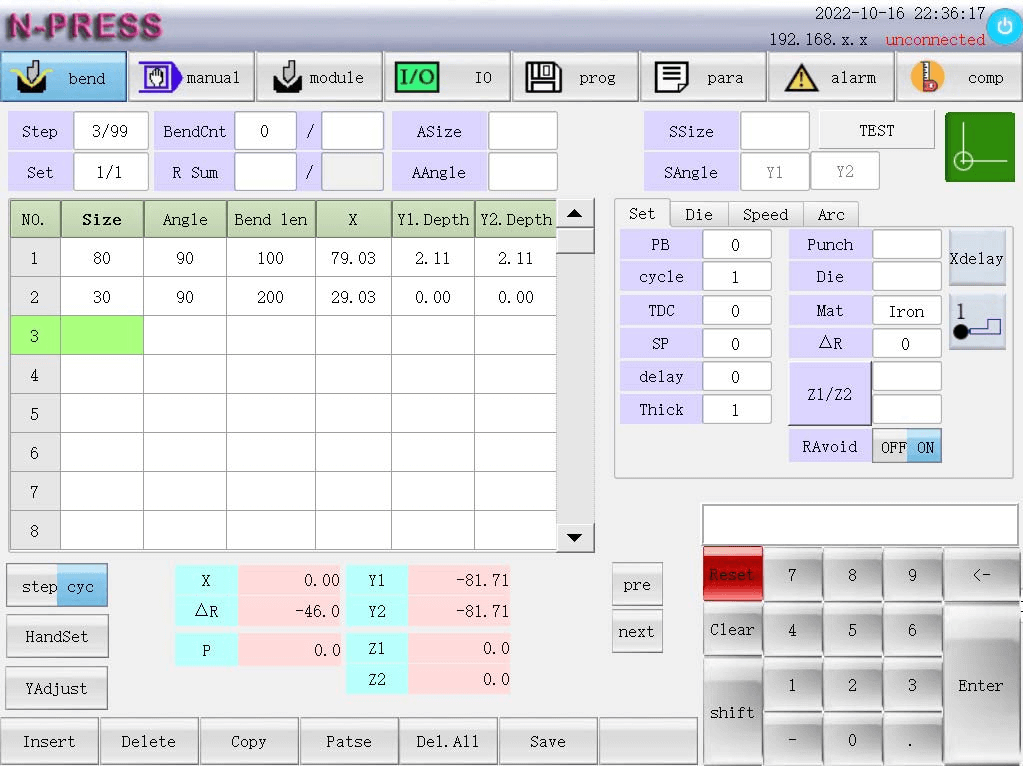

Click the processing function key to edit the bending program and set the bending parameters.
Navigating the ET Series Display
The ET Series Processing display provides real-time updates crucial for optimizing machine performance. Key features include:
- Operation: Supports 99 operations (No.1 to No.99) for detailed sequencing.
- Setting: Displays the current cycle count for productivity monitoring.
- Number of Machining: Shows accumulated bends for maintenance tracking.
- Arc Steps (R Times): Displays steps for arc bends aiding precision.
- Compensations:
- Full Size Compensation: X-axis global correction.
- Winkel Full Compensation: Ensures consistent bending angles.
- Dimension Single Step Compensation: X-axis individual adjustments.
- Angle Single Compensation: Y1/Y2 axis fine-tuning.
- Origin Mode: Automatically initiates origin mode for axis readiness.
- Axis Coordinates: Displays current coordinates for X, Y1, Y2, ΔR, Z1, Z2.
- Pressure Indicator: Shows required bending pressure tonnage.
- Step Navigation: Easily move between steps for sequencing.
Utilizing these features of the ET Series Processing display enhances operational accuracy and efficiency, supporting SEO by aligning with user intent for precision and productivity in manufacturing processes.
Editing Bend Programs in ET Series Processing
Creating a New Bend Program
Utilize ET Series Processing by selecting ‘New Program’ on the interface. Input your desired bend angles and material thickness for customized operations. The system supports 99 serial numbers, giving flexibility for different projects. Specify the dimension for bending side length and use the “rear gear” mode for arcs, which combines calculated and additional rear gear values. Ensure the angle reflects the workpiece’s opening angle for accurate programming.
Modifying Existing Bend Programs
ET Series Processing enhances efficiency by allowing easy access and modification of saved bend programs. This capability lets you adjust key parameters such as bend angle, speed, and dimensions to optimize processes for new projects.
- Seriennummer: Manage up to 99 programs for quick reference and adjustment.
- Dimension: Set and modify the desired side length with “rear gear” mode, combining calculated and superimposed values.
- Winkel: Control the opening angle, ensuring precise arc programming for optimal workpiece shape.
- Bend Length: Customize the length of each workpiece side for accurate fitting.
- X Position: Automatically calculated, this can be adjusted post-bending for precision.
- Y1 and Y2 Depth: Automatically determined for accurate positioning from the upper die tip to the V groove.
Ensure the back stop value and its superposition exceed half the V width to avoid errors. ET Series Processing enables seamless modifications to improve bending efficiency and reduce operational downtime.
Adjusting Pull Back Parameters in ET Series
Accurate pull back settings are crucial for precise material positioning in ET Series Processing. Adjusting these settings reduces material waste and enhances precision. The pull back action occurs when the y-axis upper die tip presses against the workpiece, causing the x-axis to retreat to a designated distance. Fine-tuning these parameters optimizes efficiency and ensures accurate bending cycles.
Step-by-Step Parameter Configuration
To enhance efficiency with ET Series Processing, follow these simplified configuration steps:
- Settings Access:
Start by entering the settings menu of your Numerical Control System to begin configuring. - Pull Back Distance:
Adjust the pull back distance based on material type. This ensures the X-axis retreats correctly when the Y-axis die tip presses against the workpiece surface. - Cycle Times:
Set the number of bending cycles required for your project to maintain precision and efficiency. - Top Dead Center:
Configure the distance from the upper die tip to the lower die surface where the Y-axis will pause after each bend. - Speed Change Point:
Specify where the Y-axis changes from fast to bending speed for better control. - Pressure Holding Time:
Set how long the Y-axis holds at the bending depth, with options from 0.0 to 999.9 seconds. - Material and Mold Details:
Enter material thickness and display installed upper and lower mold names for clarity. - Materialauswahl:
Enter bending material, there are 10 kinds of materials: 0-iron; 1-aluminum; 2-stainless steel; 3-9 set by the customer. - ΔR Configuration:
Adjust ΔR to define the rear stopper distance to the lower die surface. - Z1/Z2 Adjustment:
Modify Z1/Z2 spacing to match the sheet metal’s bending width. - R Avoidance:
Enable R avoidance when working with small bending sizes to prevent collision with the lower die.
By following these streamlined steps, your ET Series Processing setup will boost the efficiency and precision of your bending machine for various metalworking tasks.
Fine-Tuning Mold Parameters for Precision
In the ET Series Processing, choosing the correct mold type is essential for optimal performance. Select a mold from the ET Series library that matches your material needs. Proper mold selection ensures precision, minimizes wear, and enhances efficiency.
Proper configuration of mold dimensions is essential for improving bending quality and machine efficiency through ET Series Processing. Here’s a simplified guide:
- Upper Mold Name: Select the specific upper mold to match the tool with the system, ensuring precision and efficiency.
- Höhe: Enter the height of the upper mold to maintain consistent bending angles.
- Winkel: Define the upper die angle to guarantee bends meet desired specifications.
- Lower Mold Base: Choose from mold base 1, 2, or 3 to suit production needs.
- Seat Height: Input the height of the lower mold seat for optimal alignment.
- Lower Mold Name: Specify the lower mold to align correctly with the upper.
- Höhe: Input the lower mold height for accurate bending depth.
- V Width: Enter the V-groove width to affect the bend’s radius.
- Winkel: Define the lower die opening angle for correct material bending.
- R Shoulder: Provide the radius of the lower die opening to maintain uniform pressure.
- Safety Distance: Ensure a proper safety distance from the lower die to the V-groove center for safety and machine longevity.
By accurately setting these parameters, ET Series Processing enhances precision and increases efficiency, reducing waste and maximizing productivity.
Optimizing Speed Parameters for Efficiency
ET Series Processing in full electric servo bending machines offers precise control over various parameters, significantly boosting efficiency and precision. Here’s how:
- Speed Optimization
- Lower High Speed: Quickly moves the ram from the top dead center to the speed change point, reducing idle time.
- Upper High Speed: Speeds up the return to the top dead center, preparing the machine swiftly for the next cycle.
- Lower Low Speed: Controls precision movement from the speed change point to the bending angle, minimizing errors.
- Upper and Lower Speed: Balances efficiency and accuracy after bending, preventing machine wear.
- Precision Adjustments
- Compaction Correction: Calibrates the distance between the y-axis slider and the plate for precise bends.
- Slow Lifting Distance: Optimizes transition speeds post-bending, reducing cycle times.
- Safety and Flexibility
- R Pull Back: Prevents workpiece interference with the back gear, enhancing safety.
- Apply All: Ensures consistent application of speed settings across all operations for uniform quality.
ET Series Processing streamlines operations by fine-tuning speed and movement while maintaining quality and safety, making it an essential tool for enhancing machine efficiency.
Setting Arc Parameters in ET Series
For efficient use of ET Series Processing, properly configuring arc settings on your servo bending machine is essential. Here’s a simple guide to help you achieve perfect arcs:
- Arc Radius: Input the desired radius of the arc. Accurate entry here ensures smooth bends and prevents material deformation.
- Arc Times: Enter the number of bends needed to form the arc. This helps ET Series Processing optimize the bending process for speed and precision.
- Bend Spacing: Set the distance between each bend. Proper spacing is crucial for achieving consistent, high-quality arcs without overlaps or gaps.
By following these steps in ET Series Processing, you enhance bending machine efficiency and ensure high-quality results.
Utilizing Sub Functions for Maximum Versatility
In the realm of the ET Series Processing, exploring the various sub functions is essential to fully leverage the capabilities of a full electric servo bending machine. The system’s flexibility allows users to customize these sub functions to meet specific production needs, enhancing the machine’s versatility.
Processing Mode
Machining mode can select single step cycle mode and continuous cycle mode.
- Single step loop: Select the single step cycle mode, that is, the system circulates to execute the specified one-line program.
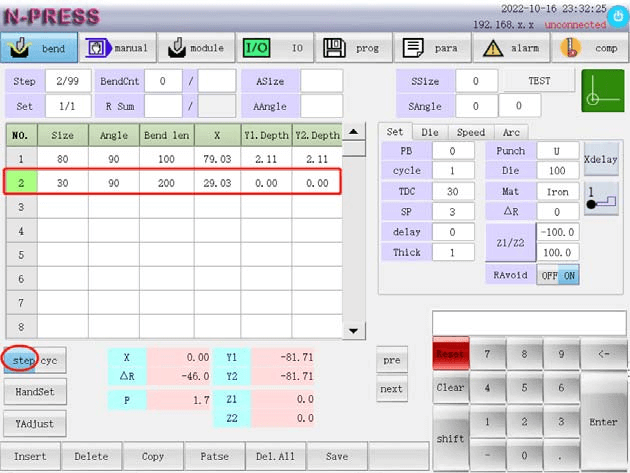
- Continuous loop: Select the continuous loop mode, that is, the system executes the specified multiline program in a loop.
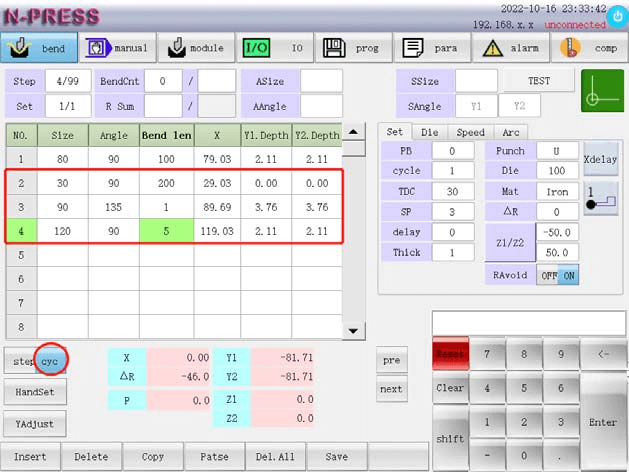
Handwheel Setting
Press plate point setting or bending point setting can be selected through ‘HandSet‘, as shown in the figure.
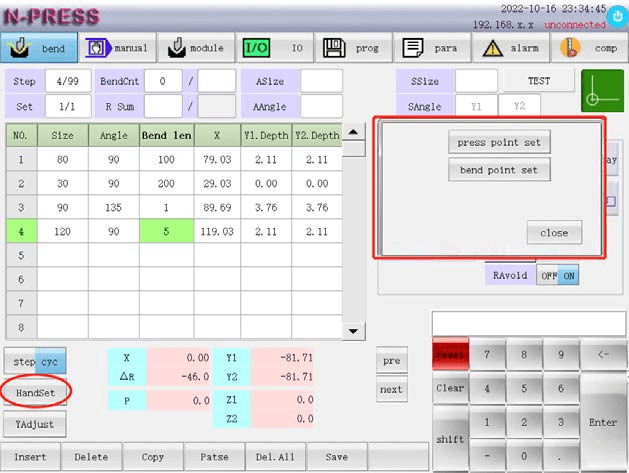
Y-axis Correction
When the Y-axis reaches the lowest bending position, it will pause. At this time, you can modify the bending depth compensation value by turning the handwheel to the required depth.
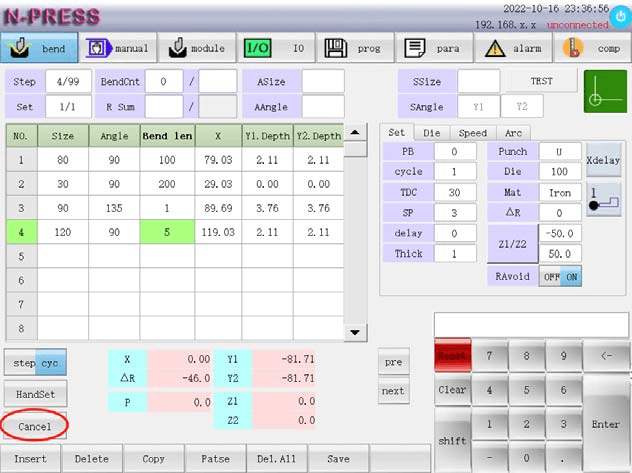
Insert Row
Insert a line before any line, for example, insert a line before line 2.
Select any column in the second row, click the sub function keys ‘Insert‘ and the system will insert a line at the corresponding position.
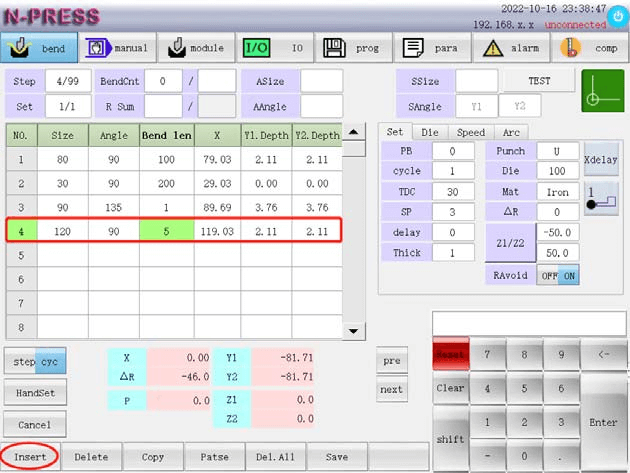
Zeile löschen
You can delete any line, for example, delete line 2.
Select any position to delete the second line, click the sub function key ‘Delete’ and the system will pop up “delete line” and select “YES” to delete the corresponding line successfully.
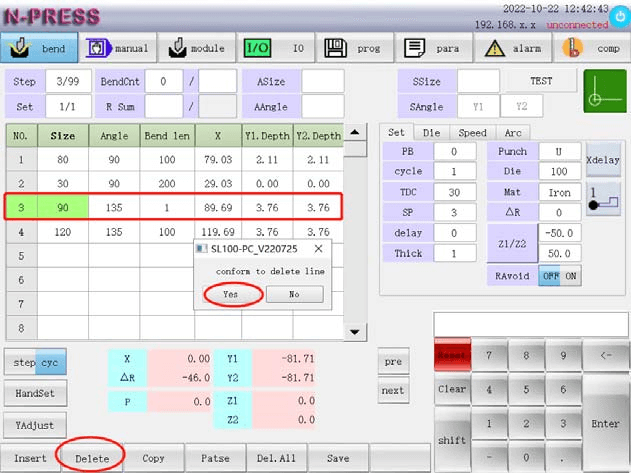
Copy Line
Any line in the bending program can be copied, for example: copy the contents of line 1.
Select any position of the first line to be copied, click the sub function key ‘Kopie‘ to copy the contents to the paste board successfully.
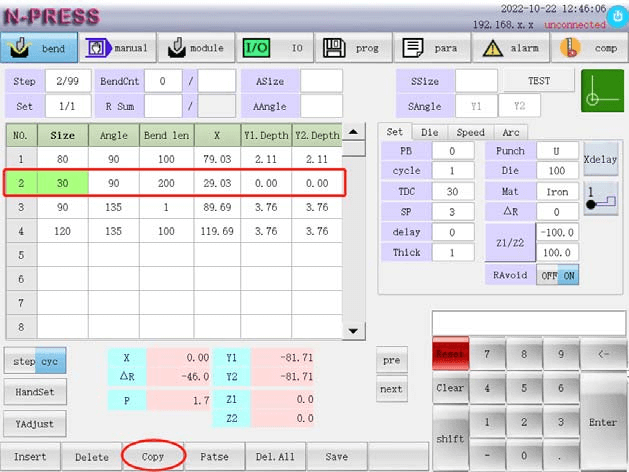
Paste Row
The contents on the pasting board can be pasted to any position in the program. For example, paste the contents of the first line to the fourth blank line.
First copy the contents of line 1, click anywhere on line 6. Click the sub function key ‘Patse‘ to copy the contents to the paste board successfully.
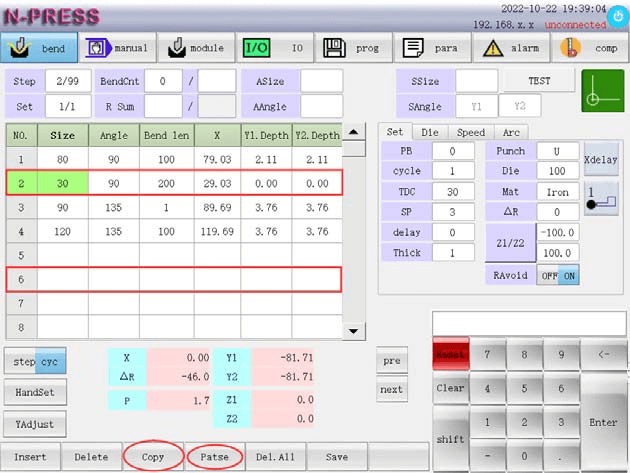
Note: if the pasted line has content, the system will overwrite the original content of the line.
Delete All
Delete all data in the programming interface.
Click the sub function key ‘Del.All’ and the system will “delete successfully!”; As shown in the figure.
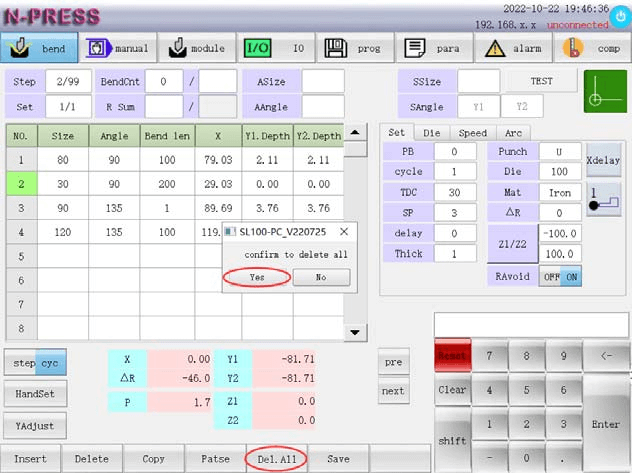
Preservation
Save all data of the programming interface.
Enter the processing interface, after editing the program, click ‘Speichern‘ as shown in the figure.
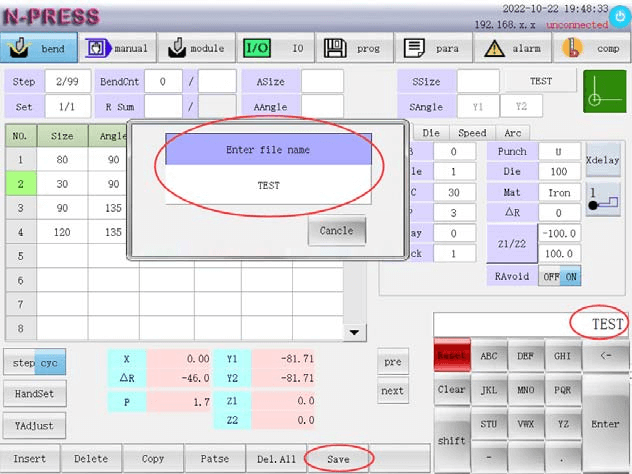
After entering the file name, click Enter on the auxiliary keyboard to save the program, and the system will prompt “file saved successfully!” As shown in the figure:
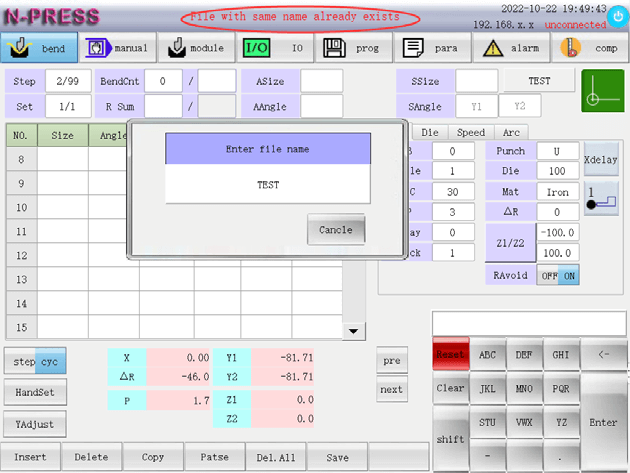
Häufig gestellte Fragen (FAQ)
What steps can I take if my machine isn’t bending accurately?
Make adjustments using the Handwheel setting feature to refine the press plate and bending point settings. Additionally, apply the Y-axis correction available in ET Series Processing to tweak bending depth compensation as needed.
How can I optimize my press brake settings with ET Series Processing?
To maximize efficiency, utilize the ET Series Processing’s sub function capabilities to customize the cycle modes according to your production needs. For instance, leverage the continuous cycle mode for longer runs to minimize downtime, ensuring seamless and efficient operations.
Abschluss
In summary, ET Series Processing significantly enhances the efficiency of Full Electric Servo Bending Machines by offering customizable sub functions, precise configuration options, and seamless integration into existing workflows. Key steps such as configuring arc settings, mastering cycle modes, and utilizing sub functions like copying, pasting, and row manipulation optimize the machine’s performance and increase production capabilities.
For further inquiries or detailed support on maximizing the potential of your ET Series Processing, don’t hesitate to contact our team. Additionally, explore our comprehensive documentation to discover more strategies for improving your servo bending machine’s performance.













